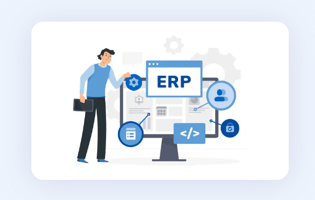Scalability is a critical factor in the success of any business software, especially in the realm...
Reducing Healthcare Costs Through Technology
Introduction
In the ever-evolving landscape of healthcare, the quest for reducing healthcare costs through technology has become paramount. This article delves into the multifaceted approaches leveraging cutting-edge solutions, aiming not only to curtail expenses but also to enhance the overall quality of patient care.
Leveraging Telemedicine
Remote Consultations: Telemedicine revolutionizes access to healthcare by enabling remote consultations. Patients can connect with healthcare professionals, breaking down geographical barriers and reducing the need for physical visits.
Monitoring Chronic Conditions Remotely: Technology facilitates the remote monitoring of chronic conditions, allowing healthcare providers to track vital signs and intervene promptly, preventing costly emergency situations.
Electronic Health Records (EHR)
Streamlining Information: EHR systems streamline patient information, ensuring quick access for healthcare providers. This not only improves efficiency but also minimizes the chances of errors, reducing the need for costly corrective measures.
Enhancing Coordination Among Healthcare Providers: Seamless sharing of patient data among different healthcare entities enhances coordination. This collaborative approach helps in avoiding redundant tests and procedures, directly impacting costs.
Artificial Intelligence in Diagnostics
Improving Accuracy in Diagnosis: AI plays a pivotal role in enhancing diagnostic accuracy. By analyzing vast datasets, AI can identify patterns that might be overlooked by human practitioners, leading to more precise and cost-effective diagnoses.
Early Detection of Potential Health Issues: AI algorithms can predict potential health issues based on individual health data, enabling proactive intervention. Early detection not only improves patient outcomes but also prevents the escalation of healthcare costs.
Wearable Technology for Preventive Care
Tracking Physical Activity: Wearable devices empower individuals to monitor their physical activity and health metrics. This proactive approach to preventive care can significantly reduce the incidence of chronic illnesses, thereby lowering long-term healthcare costs.
Promoting Proactive Health Measures: Wearable technology encourages users to adopt healthier lifestyles, reducing the burden on the healthcare system. This shift towards prevention over treatment is a fundamental strategy for cost reduction.
Streamlining Administrative Processes
Automated Billing and Claims Processing: Technology streamlines administrative tasks such as billing and claims processing. Automation reduces errors, accelerates payment cycles, and minimizes administrative overhead, contributing to overall cost savings.
Reducing Paperwork and Administrative Overhead: The adoption of digital processes eliminates the need for extensive paperwork, reducing administrative overhead. This not only saves time but also cuts down on the resources required for manual record-keeping.
Big Data Analytics for Cost Predictions
Identifying Cost Patterns and Trends: Big data analytics analyzes vast sets of healthcare data to identify cost patterns and trends. This proactive approach enables healthcare organizations to predict and manage costs more effectively.
Enhancing Decision-Making for Cost-Effective Solutions: Informed decision-making, driven by data analytics, helps healthcare administrators implement cost-effective solutions. This strategic approach addresses financial challenges, ensuring sustainable healthcare services.
Mobile Health Apps for Patient Engagement
Encouraging Self-Management of Health: Mobile health apps empower individuals to actively participate in their health management. This shift towards self-management reduces the reliance on extensive healthcare services, contributing to cost reduction.
Facilitating Communication Between Patients and Doctors: Mobile apps facilitate communication between patients and healthcare providers. This open channel ensures timely interventions, preventing costly complications and hospitalizations.
Cybersecurity Measures for Patient Data
Ensuring the Safety and Privacy of Health Information: As technology advances, ensuring the cybersecurity of patient data is paramount. Implementing robust cybersecurity measures builds trust among patients and healthcare providers, encouraging wider adoption of technology.
Building Trust in Technology Solutions: Trust is crucial in the adoption of healthcare technology. Establishing secure systems and transparent practices fosters trust, paving the way for increased utilization of technology-driven cost-saving solutions.
Challenges in Implementing Tech Solutions
Initial Costs and Implementation Challenges: While technology promises long-term cost benefits, the initial investment can be substantial. Overcoming these upfront costs and addressing implementation challenges are crucial for realizing the full potential of technology in cost reduction.
Overcoming Resistance to Technological Changes: Resistance to change is a common hurdle in the healthcare industry. Educating stakeholders and fostering a culture of adaptability are essential in overcoming resistance and ensuring the successful integration of technology.
Future Prospects and Innovations
Emerging Technologies in Healthcare: The future holds exciting possibilities with emerging technologies such as blockchain, 5G, and virtual reality. These innovations have the potential to revolutionize healthcare processes, further driving down costs.
Potential Breakthroughs in Cost Reduction: Ongoing research and development are likely to yield breakthroughs in cost reduction. From personalized medicine to innovative treatment modalities, the future promises transformative changes that could reshape the healthcare cost landscape.
Conclusion
In conclusion, the journey towards reducing healthcare costs through technology is an ongoing and dynamic process. By embracing telemedicine, AI diagnostics, wearable tech, and streamlined administrative processes, the healthcare industry can forge a path towards sustainable, cost-effective, and patient-centric care. As we navigate the challenges and seize the opportunities presented by technological advancements, the potential for positive change in healthcare cost dynamics is truly boundless.


